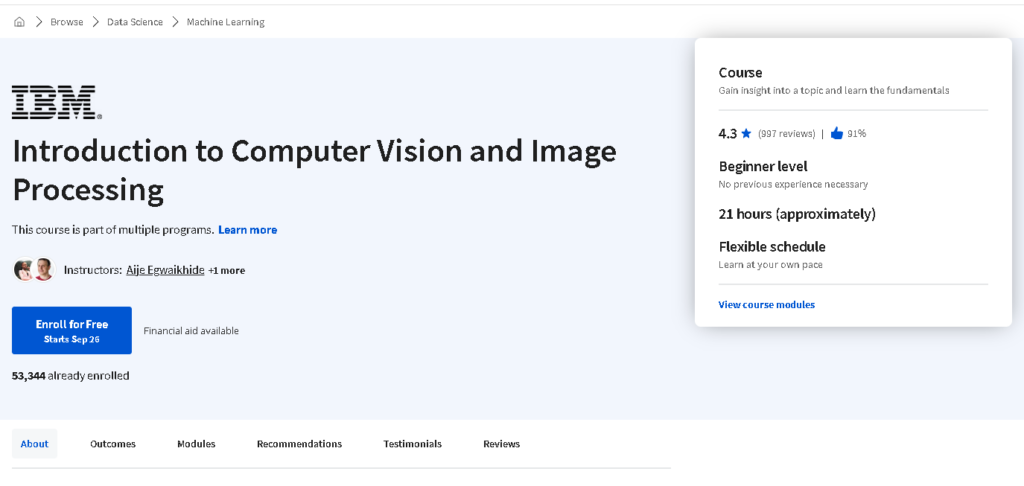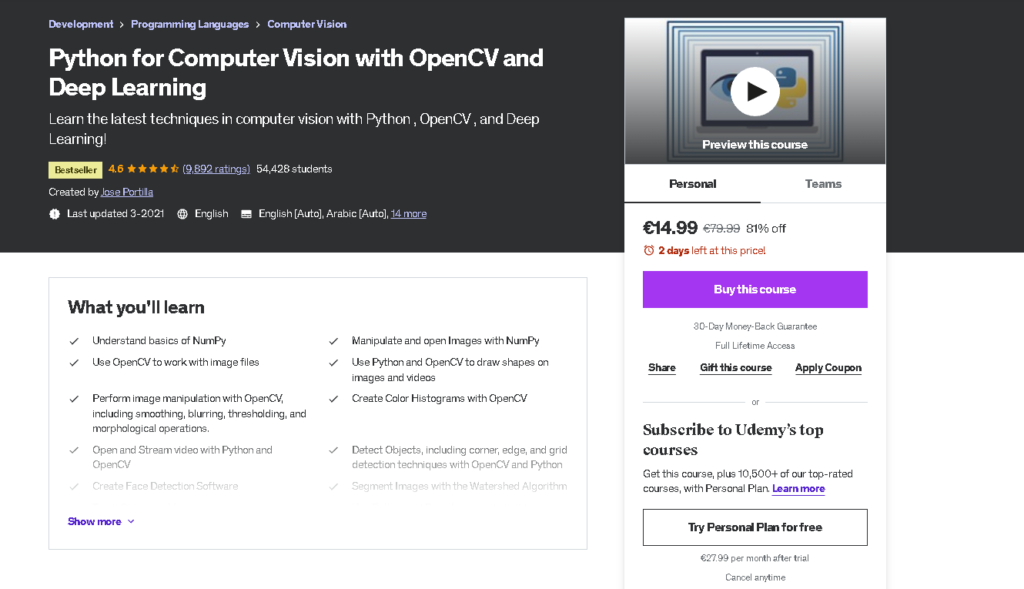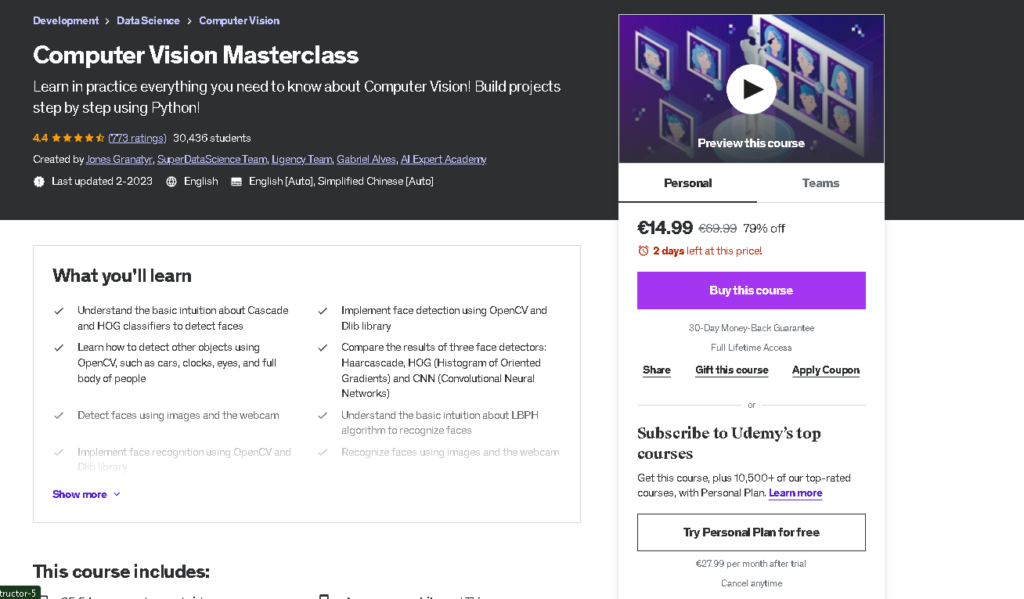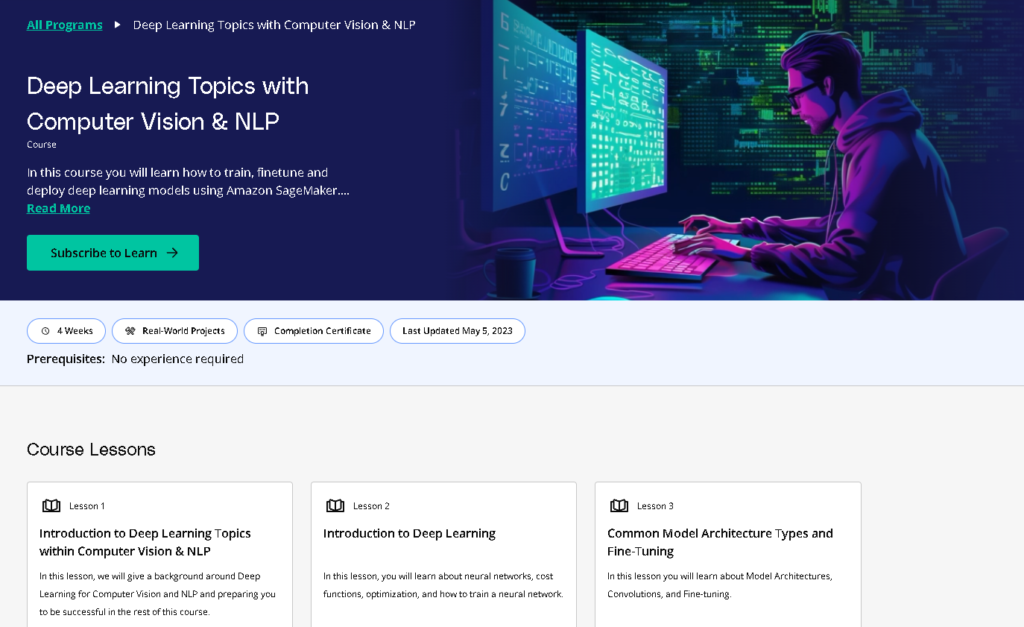Welcome to our comprehensive guide on the “Best Computer Vision Courses” available today.
In the ever-advancing realm of technology, computer vision is at the forefront of innovation, enabling machines to interpret and understand the visual world.
Whether you’re a novice looking to embark on your computer vision journey or an experienced practitioner seeking to elevate your skills, this guide will navigate you through a range of courses and programs tailored to your needs.
Join us as we delve into the world of the best computer vision courses and discover the ideal educational path to unlock your full potential in this dynamic field.
Here are the Top 7 Best Computer Vision Courses To Take in 2023
1. Computer Vision Nanodegree (Udacity)
2. Introduction to Computer Vision and Image Processing (Coursera)
3. Python for Computer Vision with OpenCV and Deep Learning (Udemy)
4. Computer Vision 101: Let’s Build a Face Swapper in Python (Skillshare)
5. Computer Vision Masterclass (Udemy)
6. Advanced Computer Vision and Deep Learning (Udacity)
7. Deep Learning Topics with Computer Vision & NLP (Udacity)
Let’s get started with my number 1 pick for this best computer vision courses list…
1. Computer Vision Nanodegree (Udacity)

Are you eager to dive into the world of computer vision and seek a top-notch educational program?
Look no further than the Computer Vision Nanodegree offered by Udacity. My number 1 on this best computer vision courses list for a reason!
In this section, we’ll explore what this program offers, who it’s designed for, the curriculum you can expect, pricing details, pros and cons, the refund policy, and provide a summary to help you make an informed decision.
Who is Computer Vision Nanodegree For?
- Beginners with little to no background in computer vision
- Professionals looking to enhance their computer vision skills
- Those with prior programming experience (beneficial but not mandatory)
What You Will Learn
- Image processing techniques
- Convolutional neural networks (CNNs) and their applications
- Object detection and recognition
- Real-world computer vision project development
How Much Is Computer Vision Nanodegree?
The cost of enrolling in the Computer Vision Nanodegree can vary, so it’s essential to check Udacity’s official website for the most up-to-date pricing information. Keep an eye out for any discounts or scholarships that might be available.
Pros
- Comprehensive curriculum
- Hands-on project opportunities
- Access to industry mentors
- Flexible learning schedule
Cons
- Relatively high cost
- Time-intensive commitment
Refund Policy
Udacity offers a 7-day money-back guarantee for the Computer Vision Nanodegree. If you decide the program isn’t the right fit for you within the first week, you can request a refund.
In Summary
The Computer Vision Nanodegree from Udacity is a comprehensive and flexible program designed to cater to a wide range of learners.
It covers essential computer vision concepts, offers hands-on experience, and provides mentorship opportunities, making it my number one on this list of best computer vision courses.
While the cost may be a consideration, the quality of education and industry relevance make it a worthwhile investment for those serious about advancing their computer vision skills.
2. Introduction to Computer Vision and Image Processing (Coursera)

If you’re considering a solid foundation in computer vision and image processing, look no further than the Introduction to Computer Vision and Image Processing course offered on Coursera.
In this section, we’ll delve into what this course offers, who it’s intended for, the topics you’ll explore, pricing details, as well as the course’s pros, cons, and refund policy to help you make an informed choice.
Who is Introduction to Computer Vision and Image Processing For?
- Aspiring computer vision enthusiasts seeking a foundational course.
- Individuals with basic programming skills looking to expand into image processing.
- No prior computer vision experience required; suitable for beginners.
What You Will Learn
- Fundamentals of computer vision and image processing.
- Techniques for image enhancement, segmentation, and feature extraction.
- Hands-on experience through practical assignments and projects.
- Insight into real-world applications of computer vision.
How Much Is Introduction to Computer Vision and Image Processing?
This Coursera course is completely free to enroll for anyone interested in learning more about computer vision. You get 21 hours of content for absolutely nothing, a real no-brainer if you ask me.
Pros
- Accessible for beginners: No prior experience necessary.
- Well-structured content: Covers fundamental concepts in a clear manner.
- Practical projects: Apply your learning to real-world scenarios.
- Flexible schedule: Learn at your own pace.
Cons
- Limited advanced topics: May not cover highly specialized or advanced techniques.
- No direct mentorship: Does not have personalized guidance.
Refund Policy
Coursera offers a refund policy within the first 2 weeks of enrollment. If you are unsatisfied, you can ask for a refund with no questions asked.
In Summary
The Introduction to Computer Vision and Image Processing course on Coursera provides a solid introduction to the world of computer vision and image processing. It’s beginner-friendly, offering well-structured content and hands-on projects. While it may not cover highly specialized topics, it’s an excellent choice for those looking to build a foundational understanding of computer vision.
Consider enrolling in this course if you’re seeking accessibility, a flexible schedule, and the opportunity to gain practical experience. However, if you’re looking for advanced topics or personalized mentorship, you might want to explore other options among this best computer vision courses list.
3. Python for Computer Vision with OpenCV and Deep Learning (Udemy)

If you’re looking to master computer vision with Python, the Python for Computer Vision with OpenCV and Deep Learning course on Udemy might be just what you need.
In this section, we’ll explore who this course is designed for, what you can expect to learn, pricing details, the course’s pros and cons, and the refund policy, helping you make an informed decision.
Who is Python for Computer Vision with OpenCV and Deep Learning For?
- Aspiring computer vision developers and enthusiasts seeking practical Python skills.
- Those with a basic understanding of Python and programming fundamentals.
- No prior computer vision experience is required, making it suitable for beginners.
What You Will Learn
- Comprehensive understanding of computer vision concepts.
- Hands-on experience with OpenCV and deep learning frameworks.
- Building real-world computer vision applications like image classifiers and object detectors.
- Insight into state-of-the-art computer vision techniques.
How Much Is Python for Computer Vision with OpenCV and Deep Learning?
This Udemy Course costs you $79.99 and will give you access to 92 lectures with a total of 14 hours of content. Look out for discounts as Udemy often makes courses like this sell for only $15 or even less.
Pros
- Beginner-friendly: Suitable for those with basic Python knowledge.
- Practical projects: Apply your skills to real-world applications.
- In-depth content: Covers computer vision and deep learning extensively.
- Lifetime access: Access course materials indefinitely after purchase.
Cons
- Self-paced: Requires self-motivation to complete the course.
- No direct mentorship: Limited personalized guidance.
- Pricing variability: Course prices may fluctuate.
Refund Policy
Udemy offers a 30-day money-back guarantee for courses. Be sure to review Udemy’s refund policy for specific details.
In Summary
The Python for Computer Vision with OpenCV and Deep Learning course on Udemy is an excellent choice for those looking to acquire practical computer vision skills with Python.
It caters to beginners, provides hands-on experience, and covers both OpenCV and deep learning extensively. With lifetime access to course materials, you can revisit the content whenever needed.
Consider enrolling in this course if you value a self-paced learning environment, hands-on projects, and the opportunity to delve into computer vision and deep learning.
4. Computer Vision 101: Let’s Build a Face Swapper in Python (Skillshare)

If you’ve ever dreamed of creating fun and engaging computer vision applications like face swapping, the Computer Vision 101: Let’s Build a Face Swapper in Python course on Skillshare might be the perfect choice for you.
In this section, we’ll explore who this course is designed for, what you can expect to learn, pricing details, the course’s pros and cons, and the refund policy, helping you make an informed decision.
Who is Computer Vision 101: Let’s Build a Face Swapper in Python For?
- Aspiring computer vision enthusiasts interested in practical and creative applications.
- Those with a basic understanding of Python programming.
- No prior computer vision experience required, making it beginner-friendly.
What You Will Learn
- Step-by-step guidance to create a face-swapping application using Python.
- Fundamentals of computer vision, image manipulation, and facial recognition.
- Hands-on experience in developing a unique and entertaining project.
How Much Is Computer Vision 101: Let’s Build a Face Swapper in Python?
“Computer Vision 101: Let’s Build a Face Swapper in Python” is a course that is on Skillshare. You’ll need a Skillshare Premium subscription. Skillshare Premium typically ranges from $8 to $19 per month, depending on the subscription plan you choose.
By subscribing, you will not only get access to this valuable course, but you’ll also get instant access to thousands of other courses. Get your free 30-day Skillshare trial here!
Pros
- Creative and engaging: Learn while working on a fun project.
- Beginner-friendly: Suitable for those with basic Python skills.
- Practical application: Gain hands-on experience in computer vision.
- Affordable: Skillshare’s subscription model provides access to multiple courses.
Cons
- Focused on a single project: May not cover a wide range of computer vision topics.
Refund Policy
Skillshare normally offers a 7-day free trial for all customers, but you can now get a 30-day free trial on the Skillshare Premium subscription plan. Click here to claim your 30-day free trial.
In Summary
The Computer Vision 101: Let’s Build a Face Swapper in Python course on Skillshare is a creative and accessible way to dip your toes into computer vision. It’s perfect for those looking to learn practical skills through a hands-on project without the need for prior computer vision experience.
Consider enrolling in this course if you appreciate an interactive learning approach, have a subscription to Skillshare, and want to embark on an enjoyable computer vision project.
5. Computer Vision Masterclass (Udemy)

If you’re looking for a deep dive into computer vision, the Computer Vision Masterclass course on Udemy might be your ideal choice.
In this section, we’ll explore the target audience, what you’ll gain from this masterclass, pricing details, the course’s pros and cons, and the refund policy to help you make an informed decision.
Who is Computer Vision Masterclass For?
- Aspiring computer vision professionals seeking an advanced and comprehensive course.
- Individuals with a strong programming background, including Python.
- Those with some prior experience or knowledge in computer vision who want to take their skills to the next level.
What You Will Learn
- Advanced computer vision techniques and algorithms.
- In-depth knowledge of image processing, object recognition, and deep learning.
- Practical experience through challenging projects.
- Insight into cutting-edge computer vision applications.
How Much Is Computer Vision Masterclass?
Computer Vision Masterclass is normally priced at $69.99 which gives you access to 229 lectures and a total of 25,5 hours of content. Be sure to look out for Udemy discounts, since they can reduce prices massively.
Pros
- Advanced content: Covers complex computer vision topics in detail.
- Hands-on projects: Gain practical experience with challenging assignments.
- Experienced instructor: Learn from an expert in the field.
- Lifetime access: Access course materials indefinitely after purchase.
Cons
- Not for beginners: Requires a strong programming background and prior computer vision knowledge.
- Potentially higher cost: In-depth courses may be relatively more expensive.
Refund Policy
Udemy offers a 30-day money-back guarantee for courses. This means that for every course you buy that you don’t like, you can just refund it with no questions asked. This leaves you with basically no risk to try courses.
In Summary
The Computer Vision Masterclass on Udemy is an excellent choice for individuals who are serious about advancing their computer vision skills. It’s tailored for those with a strong programming background and prior exposure to computer vision concepts.
Consider enrolling in this course if you’re looking for an advanced and in-depth learning experience, hands-on projects, and the opportunity to explore complex computer vision topics.
6. Advanced Computer Vision and Deep Learning (Udacity)

For those seeking to reach the pinnacle of computer vision and deep learning, the Advanced Computer Vision and Deep Learning program on Udacity stands as a beacon of excellence.
In this section of this best computer vision courses article, we’ll explore the intended audience for this program, the knowledge you’ll gain, pricing details, the program’s advantages and disadvantages, and the refund policy, all to help you make an informed decision.
Who is Advanced Computer Vision and Deep Learning For?
- Experienced computer vision professionals aiming to refine their skills.
- Data scientists and machine learning engineers eager to master advanced computer vision techniques.
- Those with a strong foundation in computer vision and deep learning looking to work on cutting-edge projects.
What You Will Learn
- Advanced computer vision topics including image segmentation, object detection, and tracking.
- In-depth knowledge of deep learning models such as convolutional neural networks (CNNs) and recurrent neural networks (RNNs).
- Real-world application experience through complex projects.
- Insights into the latest advancements in computer vision.
How Much Is Advanced Computer Vision and Deep Learning?
The program’s pricing may vary, so it’s advisable to visit Udacity’s official website for the most current pricing information and any available financial aid or scholarship options.
However, what I can say is that most Udacity courses are priced at $200-$500 per course/program.
Pros
- Cutting-edge curriculum: Covers the latest advancements in computer vision and deep learning.
- Challenging projects: Gain practical experience through complex assignments.
- Expert mentorship: Learn from industry professionals.
- Industry-recognized certification: Enhance your job prospects with Udacity’s certificate.
Cons
- Requires a strong background: Designed for those with prior experience in computer vision and deep learning.
- Potentially higher cost: Comprehensive programs may be relatively more expensive.
Refund Policy
On Udacity, you only get a refund in the first 7-14 days of your subscription plan. If you decide that you don’t like it you can cancel within 14 days to get your money back.
In Summary
The Advanced Computer Vision and Deep Learning program on Udacity is a gateway to mastery in the field. Designed for experienced individuals, it offers a cutting-edge curriculum, hands-on projects, expert mentorship, and a valuable industry-recognized certificate.
Consider enrolling in this program if you’re serious about advancing your computer vision and deep learning skills to the highest level.
7. Deep Learning Topics with Computer Vision & NLP (Udacity)

For those with a passion for diving deep into the world of deep learning, the Deep Learning Topics with Computer Vision & NLP program on Udacity offers an exceptional opportunity.
In this section, we will explore the target audience for this program, the knowledge you’ll acquire, pricing details, the program’s advantages and disadvantages, and the refund policy to assist you in making an informed decision.
Who is Deep Learning Topics with Computer Vision & NLP For?
- Data scientists and machine learning practitioners looking to master deep learning techniques.
- Professionals seeking expertise in both computer vision and natural language processing (NLP).
- Individuals with a solid foundation in machine learning and a desire to work on cutting-edge projects.
What You Will Learn
- Advanced deep learning topics including convolutional neural networks (CNNs) and recurrent neural networks (RNNs).
- In-depth knowledge of computer vision and natural language processing.
- Real-world application experience through complex projects that integrate computer vision and NLP.
- Insights into the latest advancements in deep learning.
How Much Is Deep Learning Topics with Computer Vision & NLP?
The cost of enrolling in Deep Learning Topics with Computer Vision & NLP can vary, so it’s essential to check Udacity’s official website for the most up-to-date pricing information. Keep an eye out for any discounts or scholarships that might be available.
You can check the current Price here!
Pros
- Cutting-edge curriculum: Covers advanced deep learning topics along with computer vision and NLP.
- Challenging projects: Gain practical experience through complex assignments.
- Expert mentorship: Learn from industry professionals.
- Industry-recognized certification: Enhance your career prospects with Udacity’s certificate.
Cons
- Requires a strong background: Designed for those with prior experience in machine learning and deep learning.
- Potentially higher cost: Comprehensive programs may be relatively more expensive.
- Self-paced: Demands self-motivation to complete the program.
Refund Policy
Udacity only gives you a refund in the first 7-14 days of your subscription plan. If you decide that you don’t like it you can cancel within 14 days to get your money back.
In Summary
The Deep Learning Topics with Computer Vision & NLP program on Udacity is a path to mastery in deep learning, integrating computer vision and NLP. Tailored for experienced individuals, it offers an advanced curriculum, hands-on projects, expert mentorship, and a valuable industry-recognized certificate.
Consider enrolling in this program if you are committed to advancing your deep learning skills and wish to work on complex projects that span computer vision and NLP.
Best Computer Vision Courses Overview
1. Computer Vision Nanodegree (Udacity)
2. Introduction to Computer Vision and Image Processing (Coursera)
3. Python for Computer Vision with OpenCV and Deep Learning (Udemy)
4. Computer Vision 101: Let’s Build a Face Swapper in Python (Skillshare)
5. Computer Vision Masterclass (Udemy)
6. Advanced Computer Vision and Deep Learning (Udacity)
7. Deep Learning Topics with Computer Vision & NLP (Udacity)
Which Course Platform is Best?
In this best computer vision courses article, I covered some of the best Computer vision courses out there across different platforms. But how do you decide which platform is best for you and which platform will actually help you the most?
To help you decide the best platform for you, I have compared the best course platforms and Alternatives out there in various articles. Be sure to check these articles out: Skillshare vs Udemy, Datacamp vs Coursera, Udacity vs Coursera, Udemy vs Udacity, Datacamp vs Dataquest, and way more.
Wrap Up: Best Computer Vision Courses
In the rapidly evolving landscape of computer vision and deep learning, choosing the right educational path is a pivotal decision. We’ve navigated through a spectrum of the best computer vision courses and programs, each designed to cater to various skill levels and aspirations.
From foundational courses like the Introduction to Computer Vision and Image Processing on Coursera, ideal for beginners seeking a strong footing, to more advanced options like the Computer Vision Nanodegree on Udacity, tailored for those looking to hone their expertise, there’s a learning opportunity for everyone.
If your interest lies in building practical applications swiftly, you might consider the Python for Computer Vision with OpenCV and Deep Learning course on Udemy or the creative project-based approach of Computer Vision 101: Let’s Build a Face Swapper in Python on Skillshare.
For those with a passion for pushing the boundaries of knowledge, the Advanced Computer Vision and Deep Learning program on Udacity and the Deep Learning Topics with Computer Vision & NLP program, also on Udacity, offer advanced studies in cutting-edge technologies.
Ultimately, your choice should align with your current skill level and your goals in the field of computer vision and deep learning. Whichever path you embark on, remember that learning is a journey, and every step you take brings you closer to mastery. So, seize the opportunity that resonates with you, and embrace the exciting world of computer vision and deep learning.
I hope this list of the best computer vision courses out there helped you with your learning journey! Happy learning!
Check out all the platforms I mentioned in this article by clicking the buttons below:

